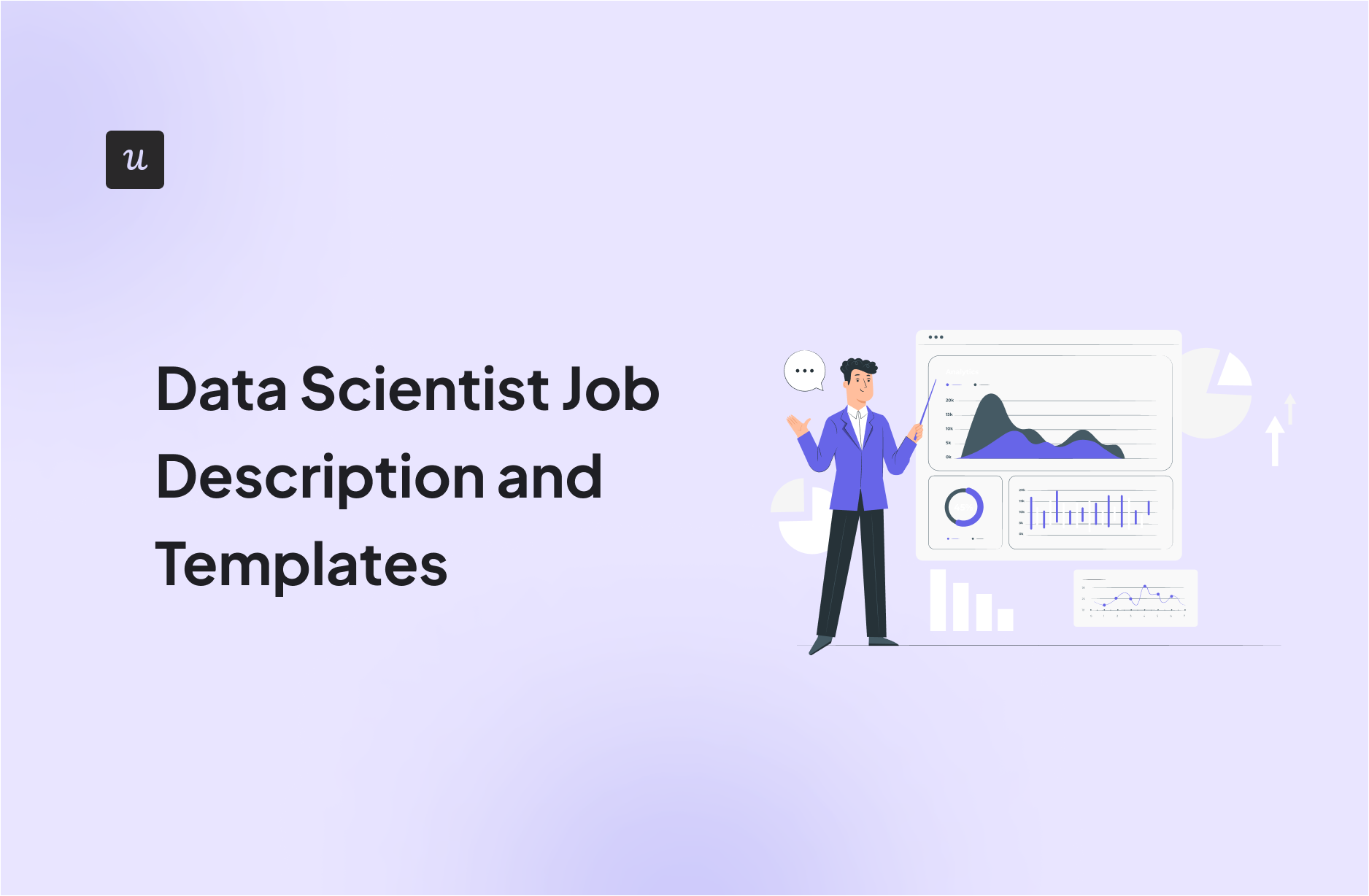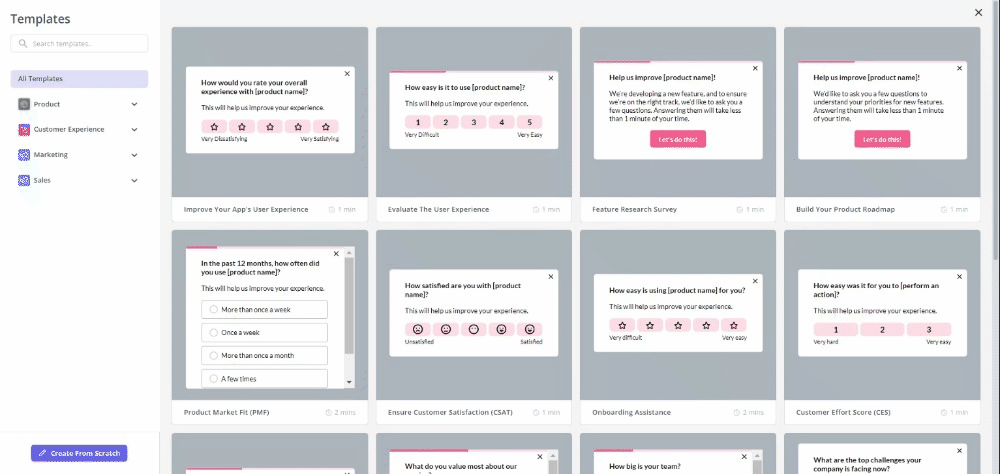
Interested in data scientist roles? You’re in the right place!
In this guide, we’ll explore the ins and outs of data scientist roles through detailed job descriptions and handy templates.
Whether you’re hiring, job hunting, or simply curious, we’ve got you covered with practical insights and ready-to-use resources.
Let’s dive in!
Try Userpilot Now
See Why 1,000+ Teams Choose Userpilot

What is a data scientist?
A data scientist is someone who uses their knowledge of statistics, programming, and specific industry expertise to extract meaningful information from data. They are basically detectives who uncover hidden patterns and trends in data, which businesses can then use to make better decisions.
Data scientists are in high demand because more and more organizations are collecting massive amounts of data. This data can come from many sources, such as customer transactions, social media, and sensors. But just having a lot of data isn’t enough. Businesses need data scientists to make sense of it all and turn it into actionable insights.
Data scientist’s main responsibilities
The three responsibility pillars of a data scientist encompass Data Acquisition and Engineering, Data Analysis and Modeling, and Communication and Collaboration.
For a better understanding of this role, let’s break down the core responsibilities of a data scientist working in a SaaS company, for example:
1. Data acquisition and engineering:
- Data Extraction: SaaS products generate a ton of user data. Data scientists design and implement methods to extract this data from various sources within the SaaS application (e.g., user activity logs, product usage data). They may use APIs or write scripts to automate this process.
- Data Cleaning and Preprocessing: Raw data often contains errors and inconsistencies. Data scientists clean and prepare the data for analysis by identifying and handling missing values, outliers, and inconsistencies. This is crucial for building reliable models.
- Feature Engineering: Data scientists transform raw data into features that are informative for machine learning models. This may involve creating new variables, combining existing ones, and performing dimensionality reduction techniques.
2. Data analysis and modeling:
- Customer Segmentation: SaaS companies often have diverse customer bases. Data scientists use clustering algorithms to segment customers based on their behavior and characteristics. This helps personalize the user experience and target marketing efforts effectively.
- Churn Prediction: Customer churn is a major concern for SaaS companies. Data scientists build churn prediction models to identify customers at risk of leaving. This allows the company to take proactive steps to retain them (e.g., offering discounts, providing support).
- Recommendation Engines: Many SaaS products recommend content, features, or services to users. Data scientists develop recommendation engines using collaborative filtering or content-based filtering techniques to personalize recommendations and improve user engagement.
3. Communication and collaboration:
- Translating Insights to Action: Data scientists don’t work in isolation. They collaborate with product managers, marketing teams, and other stakeholders to translate their analytical findings into actionable business strategies. This might involve creating reports, dashboards, and presentations to communicate complex insights effectively.
- A/B Testing: Data scientists design and implement A/B tests to measure the impact of changes made to the SaaS product (e.g., new features, pricing models). This helps optimize the product for better user experience and conversion rates.
- Staying Updated: The field of data science is constantly evolving. Data scientists in SaaS need to stay updated on the latest tools, techniques, and industry trends to ensure their models remain relevant and effective.
Data scientist job description and template
Here’s a template to help you craft a compelling data scientist job description or simply to better understand the job requirements.
Data scientist job description template
Title: Data Scientist
Company: [Your Company Name]
About Us: [Company tagline or a brief mission statement (1 sentence)]
Join us and make an impact!
We’re looking for a talented and passionate Data Scientist to join our growing team. You will be instrumental in transforming raw data into actionable insights that drive real-world business results.
What you’ll do:
- Collaborate with cross-functional teams (e.g., marketing, product) to define key business questions and translate them into data-driven problems.
- Source, clean, and transform large and complex datasets from various sources.
- Design, develop, and implement machine learning models and statistical analyses to extract meaningful patterns and trends.
- Communicate complex findings through compelling data visualizations and presentations for both technical and non-technical audiences.
- Stay up-to-date on the latest data science trends, tools, and technologies.
You’re a great fit if you have:
- Master’s degree in Statistics, Computer Science, Mathematics, or a related field (or) Bachelor’s degree with relevant experience.
- Strong programming skills in Python, R, and SQL.
- Proficiency in machine learning algorithms (supervised & unsupervised learning).
- Experience with data visualization tools (e.g., Tableau, Power BI).
- Excellent communication and collaboration skills.
- A passion for data-driven problem-solving and a strong work ethic.
Bonus points:
- Experience with cloud platforms (AWS, Azure, GCP).
- Experience with big data technologies (Hadoop, Spark).
- Knowledge of our industry (if applicable).
What we offer:
- Competitive salary and benefits package.
- Opportunity to work on challenging and impactful projects.
- Collaborative and innovative work environment.
- Continuous learning and development opportunities.
- Be part of a team that’s transforming the future with data!
Ready to join us?
Submit your resume and cover letter highlighting your data science experience and why you’re a perfect fit for this role.
Best practices to be a great data scientist
To become a great data scientist, here are a few suggestions for you:
- Master the fundamentals: This might seem obvious, but a strong foundation in statistics, probability, linear algebra, and programming languages like Python (especially libraries like NumPy, Pandas, and scikit-learn) is crucial. These skills allow you to understand data, manipulate it effectively, and build robust models.
- No-code tool knowledge: While strong technical skills are important, familiarity with no-code data analysis platforms can be a plus. Tools like Userpilot, Amplitude, and Mixpanel allow even non-programmers to explore and visualize user behavior data. This can help understand user needs and inform data science projects.
- Think business first: Don’t get lost in the algorithms. Understand the business problem you’re trying to solve and translate it into actionable insights. Communicate your findings clearly and concisely to non-technical audiences.
- Embrace continuous learning: Data science is a rapidly evolving field. Stay up-to-date with the latest trends and technologies by attending conferences, reading industry blogs, and participating in online forums.
- Be a team player: Collaboration is key! Great data scientists can work effectively with cross-functional teams – engineers, product managers, and domain experts – to ensure projects have a business impact.
Data scientist FAQs
What does a data scientist do?
Data scientists identify the key questions that need answers and determine where to source the relevant data. They possess a blend of business acumen and analytical expertise, coupled with the skills to extract, clean, and present data effectively.
What is required to be a data scientist?
A bachelor’s degree in a relevant field, such as computer science, statistics, mathematics, or engineering, is typically required for entry-level data scientist positions. When discussing the qualifications for data scientists, it’s worth noting that some companies may prefer candidates with a Master’s or PhD in a related discipline.
Is data scientist a tough job?
The role likely requires a strong foundation in various technical areas and the ability to keep up with evolving technologies based on the skills mentioned. However, the specific difficulty might depend on the industry, company size, and the problems being tackled.
Is it hard to become a data scientist?
There can be a steep learning curve for those entirely new to the field due to the required technical and analytical skills. However, there are certifications, online courses, and data science degrees available to help bridge the knowledge gap.
Overall, data science seems like a demanding but rewarding field that uses data to solve problems and make informed decisions. The difficulty of entering the field depends on your background and how much you’re willing to learn.
Conclusion
We hope this guide has provided you with valuable insights into the roles and responsibilities of data scientists.
By understanding the key responsibilities and skills required, you can make informed decisions and take meaningful steps in your career or recruitment journey.
Looking into tools for data scientists? Userpilot is an all-in-one product platform with engagement features and powerful analytics capabilities. Book a demo to see it in action!








